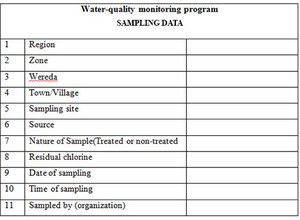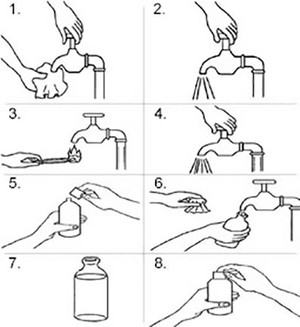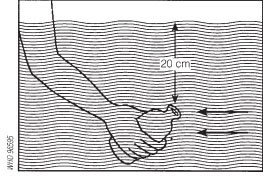Water sampling
It is important that the water that people drink is safe. Ethiopia has drinking water standards with limits for microbial, physical and chemical parameters, and you learned about these in Study Session 9. The water utilities are responsible for monitoring the quality of drinking water.
To check that drinking water quality is within standards, samples have to be carefully taken for analysis. It is important that representative samples are obtained so that they reflect an accurate assessment of the condition of the source. ‘Representative’ here means that the water sample taken represents as accurately as possible the water supply as a whole.
When water samples are collected for analysis, care should be taken to ensure that there is no external contamination of the samples. Glass bottles, rather than plastic, are best used for sampling. Both bottles and stoppers (caps) must be sterilised (to kill any micro-organisms present) so that microbiological analysis of the water sample is valid. Bottles should be clearly labelled with the place where the sample was taken and the date. A suggested form to accompany the water sample is shown in Figure 12.4. Note that residual chlorine is measured on site.

Figure 12.4 A form to accompany water samples when sent to a laboratory for analysis. (MoWR, 2002)
Details of the sample (time taken, location, etc.) and results of any measurements made should be carefully recorded and filed, so that they can be referred to later if needed.
You will now consider the sampling procedure for two different locations.
Procedure for sampling from a tap or pump outlet
To obtain a representative sample of water, the sampling procedure described below and illustrated in Figure 12.5 should be followed. The steps are:
- Clean the tap/outlet using a clean cloth to remove any dirt.
- Turn on the tap and let the water run at maximum flow for 1 to 2 minutes; then turn it off.
- Sterilise the tap outlet for a minute with the flame from a cigarette lighter or an ignited alcohol-soaked cotton-wool swab.
- Turn on the tap again and allow the water to flow for 1 to 2 minutes at a medium flow rate.
- Open a sterilised bottle by carefully unscrewing the cap.
- Immediately hold the bottle under the water jet and fill.
- While filling the bottle, hold the cap face downwards to prevent entry of dust, which may contaminate the sample.
- Screw on the cap. A small air space should be left so that the contents can be shaken more easily before analysis.

Figure 12.5 Procedure for sampling water from a tap. (WHO, 1997)
Procedure for sampling from a watercourse or reservoir
For towns and cities it is common for the water source to be a river or a reservoir, due to the large quantity of water needed each day by the population. Samples from the water source will be analysed using the following parameters:
- temperature, which can affect dissolved oxygen content and treatment
- dissolved oxygen, to determine if the water has oxygen and thus is devoid of undesirable products from anaerobic processes
- colour and odour, for acceptability to consumers
- turbidity, to determine if pre-treatment of the water is necessary
- suspended solids, to ascertain the level of treatment needed
- pH, to see if adjustment is needed
- organic compounds, metals and nitrate to determine if unacceptable levels of pollutants are present
- coliforms and pathogens, to determine the level of treatment required
- phytoplankton, to determine if removal is needed to eliminate odour and taste problems.
Phytoplankton are microscopic plants and other photosynthetic organisms that live in water.
The steps for water sampling are as follows:
- Open the sterilised bottle as described above.
- Fill the bottle by holding it by the lower part and submerging it to a depth of about 20 cm, with the mouth facing slightly upwards. If there is a current, the mouth of the bottle should face towards it (Figure 12.6).
- The bottle should then be capped.

Figure 12.6 Sampling of water from surface water (rivers, ponds, etc.). (WHO, 1997)